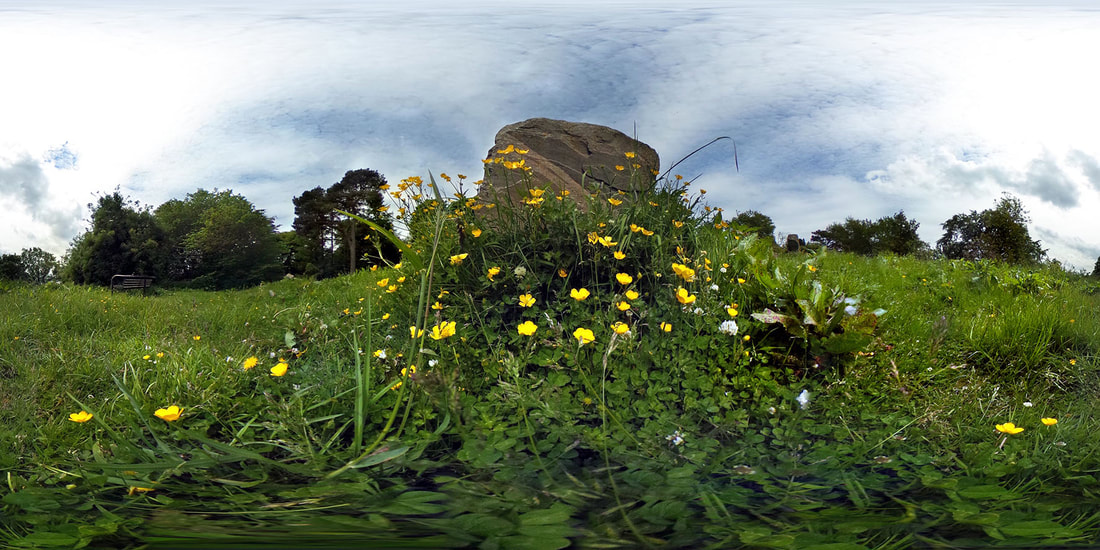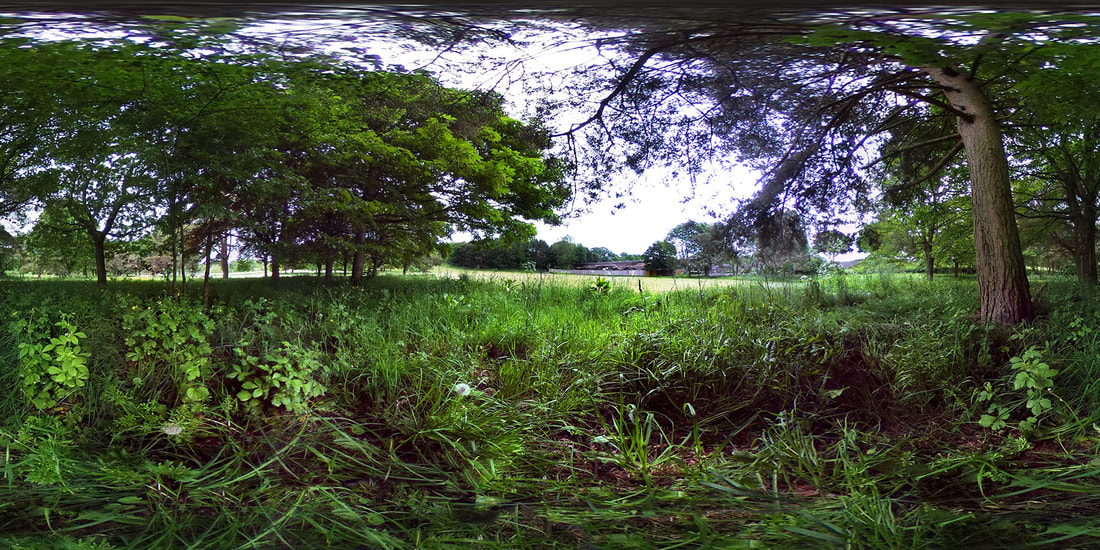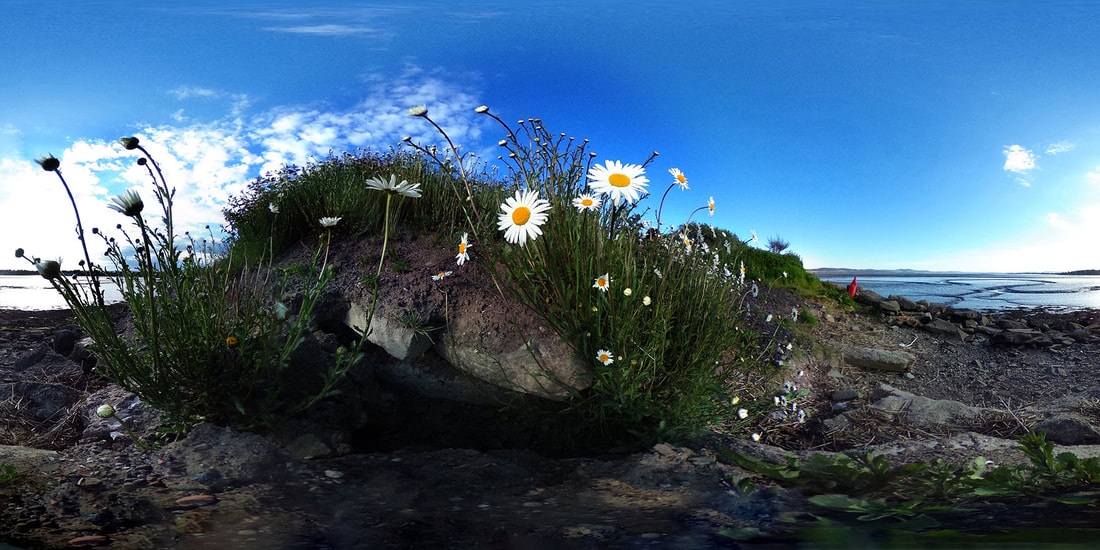Dundee City's own 'Internet of Nature'
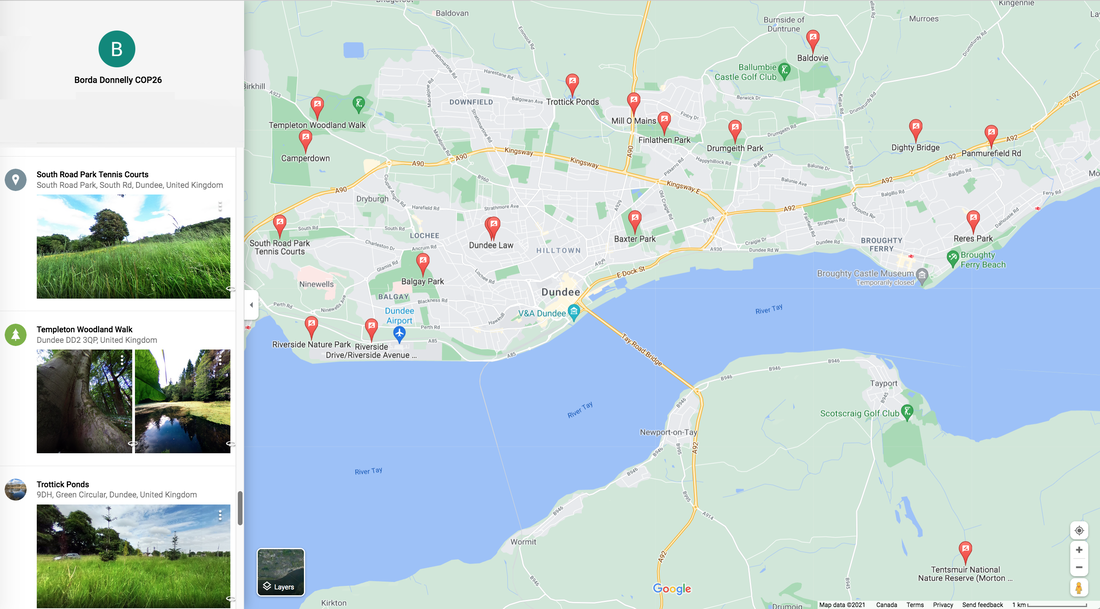
Project artists, Sylvia Grace Borda and J.Keith Donnelly /(B+D), as part of their work for 'Trees for Life' decided to create a set of learning tools designed to help Ethiopian participants to understand different methods to document mature trees and different ecological corridors. B+D started digitally documenting trees and parks in Dundee’s city parks. These ‘park portraits’ were shared with Ethiopian participants to foster dialogue and to assist in thinking about how the role of climate art can be part of impactful actions to aid in the on-going stewardship of trees and local ecologies.
Borda and Donnelly created Internet of Nature by using Dundee's park and forest strategy plan. The artists visited each green area listed in the guide to create their own Nature tour. Through their work they created an independent artwork which showcases flora and overlooked views from the perspective of plants and animals. Such low angles have been used in order to feature flora as the main subject. While Google Street View is often associated with the car and road systems, the artists have opted to go off road - instead showcasing locations where the viewer needs to walk into park land & explore it first hand.
Project artists, Sylvia Grace Borda and J.Keith Donnelly /(B+D), as part of their work for 'Trees for Life' decided to create a set of learning tools designed to help Ethiopian participants to understand different methods to document mature trees and different ecological corridors. B+D started digitally documenting trees and parks in Dundee’s city parks. These ‘park portraits’ were shared with Ethiopian participants to foster dialogue and to assist in thinking about how the role of climate art can be part of impactful actions to aid in the on-going stewardship of trees and local ecologies.
Borda and Donnelly created Internet of Nature by using Dundee's park and forest strategy plan. The artists visited each green area listed in the guide to create their own Nature tour. Through their work they created an independent artwork which showcases flora and overlooked views from the perspective of plants and animals. Such low angles have been used in order to feature flora as the main subject. While Google Street View is often associated with the car and road systems, the artists have opted to go off road - instead showcasing locations where the viewer needs to walk into park land & explore it first hand.
Of note, researchers are starting to emphasize the benefits of having access to Nature. Such exposure to our landscape spaces through digital platforms can also have positive impacts on our overall mood, health and wellbeing. Did you know that multiple studies have proven that having access to Nature - even a digital form of it can keep you healthier and happier offering both physical and psychological health benefits? Both physical and even a representation of Nature can improve your mood, reduce fatigue, lower stress and anxiety, improve focus and performance, and boost healing and pain tolerance. There are numerous other health benefits to people that are equally welcomed benefits of viewing and being around trees and these include reducing blood pressure, stress, asthma; speeding recovery from surgery and illness; enhancing attention and cognitive function; improving mental health and wellbeing; and encouraging physical activity.
These 'Internet of Nature' scenes have also other added benefits; they can be accessed at anytime, offer us views of scenes even when the weather may poor outside, and open up the possibility of those who may face access and/or mobility challenges opportunities to see Nature close-up.
The artists have composed each 360' image to be seen both as a (1) panorama artwork and as (2) an immersive online experience from the vantage of a small mammal.
In many ways, Borda and Donnelly feel they have achieved another perspective of how art can be experiential and engage with place and Nature. More of their reflections on the creation of this work can be found later in this article.
IMMERSIVE IMAGES TO EXPLORE
Each of Dundee City's Internet of Nature images below corresponds to an interactive scene or use the tiny url (https://tinyurl.com/ztd34e7h) to access all of the 50 plus Google Street View enabled webpages.
These 'Internet of Nature' scenes have also other added benefits; they can be accessed at anytime, offer us views of scenes even when the weather may poor outside, and open up the possibility of those who may face access and/or mobility challenges opportunities to see Nature close-up.
The artists have composed each 360' image to be seen both as a (1) panorama artwork and as (2) an immersive online experience from the vantage of a small mammal.
In many ways, Borda and Donnelly feel they have achieved another perspective of how art can be experiential and engage with place and Nature. More of their reflections on the creation of this work can be found later in this article.
IMMERSIVE IMAGES TO EXPLORE
Each of Dundee City's Internet of Nature images below corresponds to an interactive scene or use the tiny url (https://tinyurl.com/ztd34e7h) to access all of the 50 plus Google Street View enabled webpages.
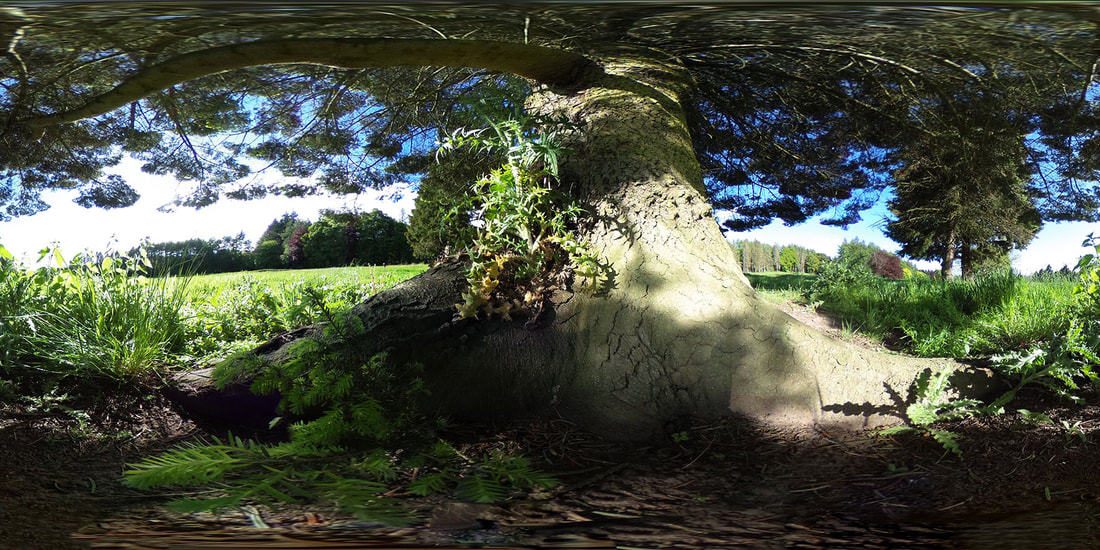
https://tinyurl.com/k7z2exfs
Camperdown Park is the largest park in the City of Dundee and it has a diverse landscape spanning from fields to forested verges. Debris nestled in the junction between this Scots pine tree trunk and its root system is now supporting an opportunistic thistle plant (The thistle is enjoying the tree canopy cover protecting it from wind and sheltering it from too much sun) While nearby around the tree's root system a new sapling is starting to sprout. The presences of stinging nettles is a sign of their capacity to grow and rehabilitate poor acidic soils slowly to a more favourable pH. Indeed the pine needles from this tree would be too acidic or toxic for most plants to take root near it.
Camperdown Park is the largest park in the City of Dundee and it has a diverse landscape spanning from fields to forested verges. Debris nestled in the junction between this Scots pine tree trunk and its root system is now supporting an opportunistic thistle plant (The thistle is enjoying the tree canopy cover protecting it from wind and sheltering it from too much sun) While nearby around the tree's root system a new sapling is starting to sprout. The presences of stinging nettles is a sign of their capacity to grow and rehabilitate poor acidic soils slowly to a more favourable pH. Indeed the pine needles from this tree would be too acidic or toxic for most plants to take root near it.
https://tinyurl.com/ctfr7eta
Balgay Park was opened in 1871 with the aspirations that it would improve the health of mill workers who lived nearby. Such factory workers in the late Victorian period worked in poor factory conditions coupled by being housed in inadequate dwellings that lacked proper ventilation to being cold and damp in the winters. To this day and like when the park opened, it offers visitors a network of footpaths, together with views across the Firth of Tay. The woodland includes now mature deciduous and coniferous trees that can be seen in the background. This image focuses on an array of buttercups and clover. While buttercups may be considered a pesty weed (they are noxious to grazing animals to eat), it is a good indicator of how moist these soils are. These weedy plants thrive in heavy wet meadows or poorly drained pastures. With climate change many pastures are drying out and the disappearance of certain weeds are an observable change in terms of drastically changing weather conditions. With rising global temperatures there is also an inability of many of the world's plants to continue to thrive in their local eco-systems. When plants cannot soak up extra carbon from the atmosphere, soil health and moisture content shifts drastically. Thankfully Balgay Park is exhibiting positive signs in terms of soil moisture and retention plus it is supporting a wide array of trees of different ages.
Balgay Park was opened in 1871 with the aspirations that it would improve the health of mill workers who lived nearby. Such factory workers in the late Victorian period worked in poor factory conditions coupled by being housed in inadequate dwellings that lacked proper ventilation to being cold and damp in the winters. To this day and like when the park opened, it offers visitors a network of footpaths, together with views across the Firth of Tay. The woodland includes now mature deciduous and coniferous trees that can be seen in the background. This image focuses on an array of buttercups and clover. While buttercups may be considered a pesty weed (they are noxious to grazing animals to eat), it is a good indicator of how moist these soils are. These weedy plants thrive in heavy wet meadows or poorly drained pastures. With climate change many pastures are drying out and the disappearance of certain weeds are an observable change in terms of drastically changing weather conditions. With rising global temperatures there is also an inability of many of the world's plants to continue to thrive in their local eco-systems. When plants cannot soak up extra carbon from the atmosphere, soil health and moisture content shifts drastically. Thankfully Balgay Park is exhibiting positive signs in terms of soil moisture and retention plus it is supporting a wide array of trees of different ages.
https://tinyurl.com/535yu67x
Finlathen Park was created where once derelict mills stood, and by in filling past industrial ponds and lades. The Dighty Burn was known as Scotland’s hardest working stream, with over 30 mills using its water. There were mill ponds, water channels, drying green and mill buildings with water wheels that all lined the stream's banks once upon a time. The Park has since been designed where a rehabilitated Dighty Burn meanders through the park, following it original course. The meadows are prone to flooding from the stream; however, this is what gives the park its character. Moist tolerant grasses are found under the shaded courses of trees.
Finlathen Park was created where once derelict mills stood, and by in filling past industrial ponds and lades. The Dighty Burn was known as Scotland’s hardest working stream, with over 30 mills using its water. There were mill ponds, water channels, drying green and mill buildings with water wheels that all lined the stream's banks once upon a time. The Park has since been designed where a rehabilitated Dighty Burn meanders through the park, following it original course. The meadows are prone to flooding from the stream; however, this is what gives the park its character. Moist tolerant grasses are found under the shaded courses of trees.
https://tinyurl.com/9vdwc4n
An engineered and built constructed land jetty in 1830 to being later the city's landfill from 1967-1996, Riverside Nature Park has had a long history of being associated with various heavy and polluting industries. Now a rehabilitated and consolidated site from 2011 to present, it is managed by the City, and has been successfully planted with trees and wildflowers to create an extensive set of wildlife corridors. The beaches are now also starting to support increased bird and fish populations alongside the Tay estuary river system.
An engineered and built constructed land jetty in 1830 to being later the city's landfill from 1967-1996, Riverside Nature Park has had a long history of being associated with various heavy and polluting industries. Now a rehabilitated and consolidated site from 2011 to present, it is managed by the City, and has been successfully planted with trees and wildflowers to create an extensive set of wildlife corridors. The beaches are now also starting to support increased bird and fish populations alongside the Tay estuary river system.
Borda and Donnelly - Artists' reflections on the creation of Dundee's 'Internet of Nature'
"What we are most inspired by is that the Internet of Nature consists of photographic artworks which chronicle each of Dundee’s civic parks but from unexpected vantage points. These landscape images are captured from low perspectives as seen from the sightline of plants or small animals crouching against the landscape. As artists we have shifted the human-animal sightline with startling results. In walking across long swathes of park systems, we have come to know Dundee in a way few of its residents may have experienced directly.
Our ‘Internet of Nature’ plays with concepts of what is not typically seen online and therefore not explored. These artworks are aligned both with a practice of past documentary photography, concerned with the careful choice and framing of its subject and composition and conceptual frameworks of salvage. The entire City of Dundee has become our artwork. The art exists as two corresponding bodies of work.
Viewers online can visit these artworks placed within Google Street View’s engine. This is a first in terms of (1) placing art and using the perspective of Nature, and (2) creating an entire virtual park system from the real purposely embedded into Google Street View’e engine. Our explored urban parks and greenways – areas reuquired us to walk into Nature verges and locations ‘off grid’ from road systems that are captured by Google Street View mounted cameras that scan across towns. Viewers local to Dundee are provided with opportunities to seek out these views caught at a particular moment and time of season. This shift in seasonal time, space and perspective invites viewers to observe, and study Nature in greater detail in the same way someone may explore and admire Durer’s “The Great Piece of Turf” (1503).
As contemporary artworks, the Internet of Nature accomplishes something distinctive than the likes of artist, Mishka Henner, known for downloading scenes from Google Street View. Our landscapes are specifically composed and uploaded into the Google Street View Engine for serendipitous discovery. In this reversed format, the artworks become similar to Felix Gonzalez Torres’ open multiples –generously available for audiences to navigate, experience, contemplate, and take-away a component. Our online artworks are designed to be observed in intimate detail in the same way someone might take a candy from a Torres installation and their take-away involves in viewers locating and framing their own tangible view of the art in each panorama.
For exhibition the photo artworks are accompanied by QR codes so viewers can enter the images. Unlike conventional photographs and Susan Sontag’s concern that only a framed composition is available to the viewer – the Google enabled photographs allow viewers to see everything across the image plane.
Internet of Nature artworks are created both as conceptual portraits of Nature and an archive of Dundee’s park systems. Critically in a time of climate change, these Nature portraits serve as aide memoires of a changing space – an index of what is present. Will future temperature variations and extreme weather events change Dundee’s urban ecologies in the future? Much like the limitation of photographic images themselves capturing a temporal moment, Internet of Nature opens up questions about how we see and what is present."
Borda + Donnelly, November 2021
"What we are most inspired by is that the Internet of Nature consists of photographic artworks which chronicle each of Dundee’s civic parks but from unexpected vantage points. These landscape images are captured from low perspectives as seen from the sightline of plants or small animals crouching against the landscape. As artists we have shifted the human-animal sightline with startling results. In walking across long swathes of park systems, we have come to know Dundee in a way few of its residents may have experienced directly.
Our ‘Internet of Nature’ plays with concepts of what is not typically seen online and therefore not explored. These artworks are aligned both with a practice of past documentary photography, concerned with the careful choice and framing of its subject and composition and conceptual frameworks of salvage. The entire City of Dundee has become our artwork. The art exists as two corresponding bodies of work.
Viewers online can visit these artworks placed within Google Street View’s engine. This is a first in terms of (1) placing art and using the perspective of Nature, and (2) creating an entire virtual park system from the real purposely embedded into Google Street View’e engine. Our explored urban parks and greenways – areas reuquired us to walk into Nature verges and locations ‘off grid’ from road systems that are captured by Google Street View mounted cameras that scan across towns. Viewers local to Dundee are provided with opportunities to seek out these views caught at a particular moment and time of season. This shift in seasonal time, space and perspective invites viewers to observe, and study Nature in greater detail in the same way someone may explore and admire Durer’s “The Great Piece of Turf” (1503).
As contemporary artworks, the Internet of Nature accomplishes something distinctive than the likes of artist, Mishka Henner, known for downloading scenes from Google Street View. Our landscapes are specifically composed and uploaded into the Google Street View Engine for serendipitous discovery. In this reversed format, the artworks become similar to Felix Gonzalez Torres’ open multiples –generously available for audiences to navigate, experience, contemplate, and take-away a component. Our online artworks are designed to be observed in intimate detail in the same way someone might take a candy from a Torres installation and their take-away involves in viewers locating and framing their own tangible view of the art in each panorama.
For exhibition the photo artworks are accompanied by QR codes so viewers can enter the images. Unlike conventional photographs and Susan Sontag’s concern that only a framed composition is available to the viewer – the Google enabled photographs allow viewers to see everything across the image plane.
Internet of Nature artworks are created both as conceptual portraits of Nature and an archive of Dundee’s park systems. Critically in a time of climate change, these Nature portraits serve as aide memoires of a changing space – an index of what is present. Will future temperature variations and extreme weather events change Dundee’s urban ecologies in the future? Much like the limitation of photographic images themselves capturing a temporal moment, Internet of Nature opens up questions about how we see and what is present."
Borda + Donnelly, November 2021
